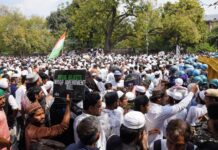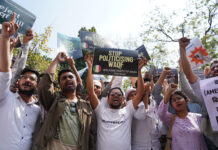The death toll caused by giant waves which crashed into coastal towns on the Indoensian islands of Sumatra and Java has reached at least 281 people, with 1,016 injured.
It is thought that volcanic activity set off undersea landslides which in turn generated the killer waves. The Anak Krakatau volcano erupted again on Sunday, spewing ash and smoke.
Rescue efforts are being hampered by blocked roads but heavy lifting equipment is being transported to badly hit areas to help search for victims.
The spokesman for the National Disaster Management Agency, Sutopo Purwo Nugroho, told a news conference that another tsunami is a possibility because of the continued volcanic eruptions of Anak Krakatau.
“Recommendations from [the] Meteorology, Climatology and Geophysical Agency are that people should not carry out activities on the beach and stay away from the coast for a while,” he said.
Anak Krakatau, which emerged in 1927 from the caldera that was formed during the eruption of Krakatoa in 1883, has seen increased activity in recent months with people asked to avoid the area around its crater.
On Monday Mr Sutopo put out a series of tweets explaining why there was no early warning for this tsunami. He said that Indonesia’s early warning system is set up to monitor earthquakes but not undersea landslides and volcanic eruptions, which can also generate deadly waves.
Subscribe to our newsletter and stay updated on the latest news and updates from around the Muslim world!
But, he added, that with 13% of the world’s volcanoes in Indonesia alone, it was crucial for the country to develop such system.
He confirmed there was no tsunami advance warning system the night of the disaster, adding that because of lack of funds, vandalism to the buoys and technical faults there had been no operational tsunami warning system since 2012.






















